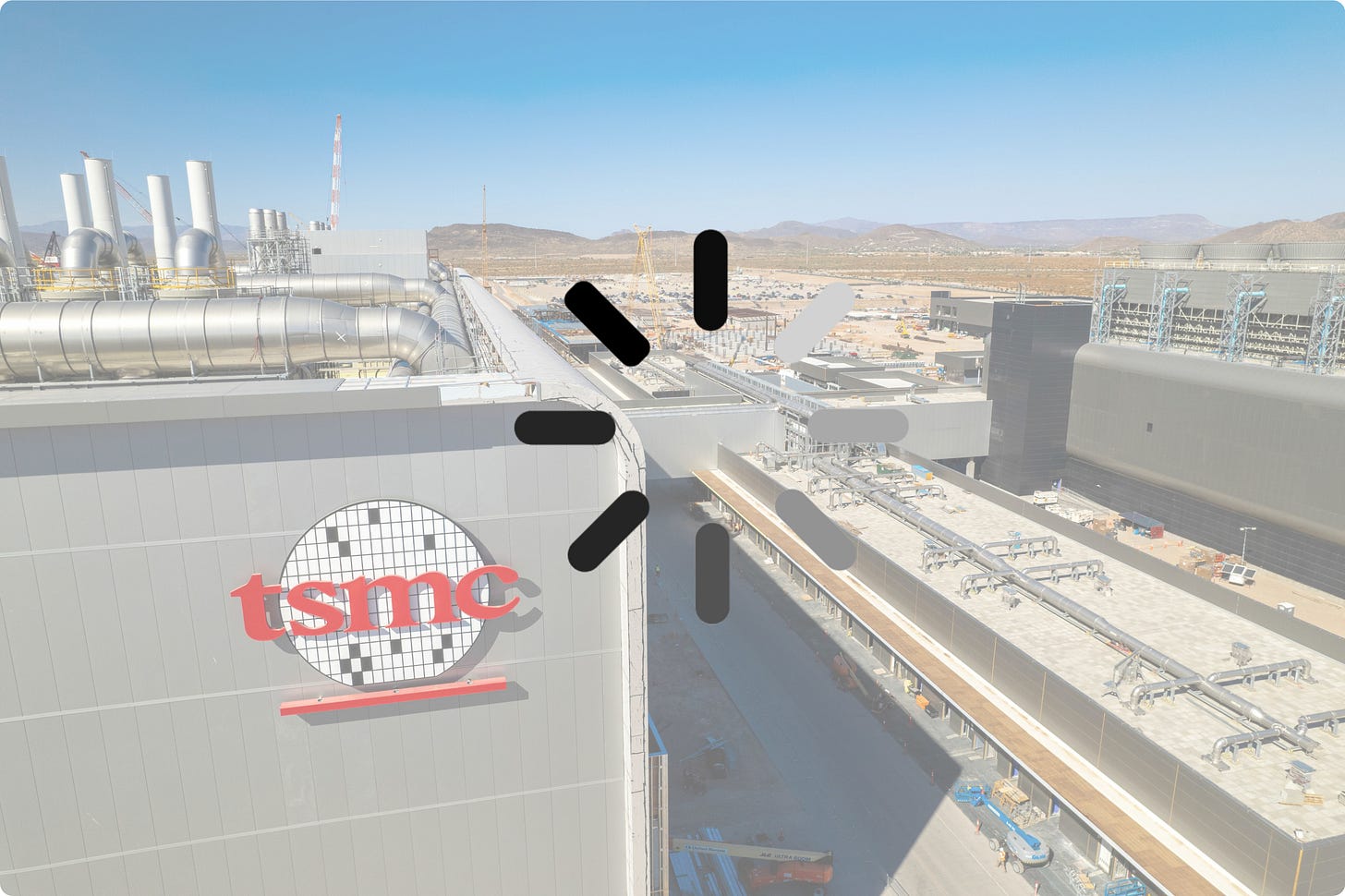TSMC Arizona Outage Saw Fab Halt, Apple Wafers Scrapped
[Exclusive] Supply of industrial gases used for chipmaking was cut when power at a vendor's facilities was interrupted.
Good Evening from Taipei,
A power outage at an industrial gas facility servicing TSMC interrupted manufacturing at the company’s Fab 21 in Arizona late last quarter, sources told me. The incident stopped the flow of crucial inputs needed for chipmaking, forcing the facility to shut down for at least a few hours, I was told. As a result, the company had to scrap thousands of wafers that were in production for clients at the site which include Apple, Nvidia, and AMD.
The event happened mid-September and was caused by a power fault at its outsourced vendor Linde, a British industrial gases and engineering company, my sources tell me. TSMC runs a lot of its own gas supply in Taiwan, but opted to contract the work out for its Arizona site. While mistakes happen, and insurance may cover some of the losses from the event, Linde has been put on notice to identify and rectify the cause of the outage, I was told. A PR representative for Linde didn’t answer multiple phone calls and emails from Culpium outlining the incident and requesting comment.
TSMC’s Arizona unit turned profitable in the first quarter of this year, a sign of the Taiwanese company’s ability to quickly scale up and churn out chips even in higher-cost locales like the US. But a 99% drop in net income in the third quarter to just $1.4 million had folks scratching their head. One writer was quick to jump to conclusions, with the assumption that “rising costs have taken out an enormous chunk of profits, putting pressure on the firm’s operations.” The September outage, which hasn’t previously been reported, offers an alternative explanation for the profit decline.
“TSMC Arizona has begun to positively contribute to TSMC’s revenue. However, the company’s profit is influenced by multiple factors and should be read over time,” TSMC wrote in response to a detailed account of what Culpium has been told about the outage. “We also stated before that the ramp up for our overseas fabs will lead to gross margin dilution in the next five years, starting from 2025.”
Unfortunately, the company declined to immediately address the issue of the manufacturing disruption.
Fab shutdowns are unusual, at least for TSMC. With equipment so expensive, its factories are run 24/7. That means that an hour of idle time can cost millions of dollars. Compounding the financial effect of this incident was the fact that it occurred late in the quarter, leaving little room to make up for lost production before the quarter closed.
Profit margins on new facilities and at new nodes tend to be quite thin, even negative. In addition, TSMC has been ramping up capacity in Arizona and that capex gets reflected in depreciation costs even before the new equipment can start producing revenue. So it’s reasonable to see fluctuations in net income at the site. A halt in production and scrapping of wafers adds to the costs, dragging on earnings even if only slightly and briefly.
Impact to clients is likely to be negligible, I was told, and the financial loss to TSMC may be covered by insurance. Capacity at Fab 21 is still quite small, and many products being made there have already been taped out and manufactured in Taiwan previously. In past disruptions, lost production and revenue was made up in the subsequent quarter.
That said, the broader issue is that Taiwanese manufacturers are good at managing their operations when they handle it themselves, but still face struggles when they need to lean on non-Taiwanese firms at overseas facilities. The entire process of building the fab and installing equipment at Arizona has been an exercise in cross-cultural adaptation.
The most common cause of production interruptions at TSMC is Mother Nature. Earthquakes regularly rattle Taiwan, and fabs are built to withstand most of them. But sometimes a big tremor can trigger a safety shutdown, while really nasty temblors have caused actual damage. Beyond natural disasters, there’ve been few man-made shutdowns at TSMC because they’re pretty rigorous about operations.
A couple of notable problems were both caused by vendors, not TSMC internally. In 2018, a computer virus was introduced to fabs via equipment from Japan. That incident sparked a whole new approach to cybersecurity both at TSMC and among fellow Taiwanese chipmakers. Less than a year later, a batch of contaminated photoresist from a chemical supplier forced the company to scrap a large number of wafers. It made up the production the following quarter, with the problem costing TSMC around $25 million in operating profit for the year.
Linde trumpeted the TSMC contract when it landed the deal back in 2021, noting that it planned to invest $600 million into the facility. “While the project is capital and electricity intensive, it will only employ 14 plant employees and 14 truck drivers, documents from 2020 said,” the Arizona Tech Council later reported.
Apple’s A16 SoC was the first product taped out at the site, Culpium reported in September last year. AMD’s Ryzen 9000 and Nvidia Blackwell chips were since added to the lineup with designs from Bitdeer, among others, also qualified at the Arizona fab.
Thanks for reading. Please subscribe, if you haven’t already.
More from Culpium:









